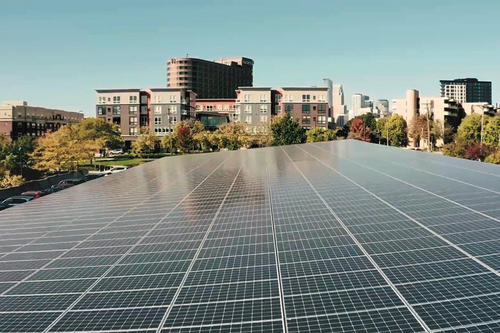
Contractors finished installing solar panels on a steel canopy above a dull parking lot next to the University of Minnesota’s Law School in 2019. They covered an empty green space next to the parking lot—and Mondale Hall’s rooftop—with panels, making the multisite solar installation the largest on campus. It's the most visual manifestation of the University’s longstanding commitment to clean energy and sustainability.
Over the past decade, the U of M has made its support of renewable energy plain by investing in solar through utility-operated clean energy programs and on-campus solar installations. And by improving building efficiency and generating energy through a relatively new combined heat and power plant—less noticeable but still important developments—the University has reduced its greenhouse gas emissions by at least 39 percent over the past 11 years.
Beyond targeting the campus’s energy consumption, the University relies on research by scientists, architects, and policy experts to develop pathways to green the state and country’s power infrastructure.
As part of President Joan Gabel’s MPact Systemwide Strategic Plan, the U of M is implementing a next-generation Climate Action Plan for 2030, including proposing a plan for each of its five campuses.
The ultimate goal: Reduce greenhouse gases and waste while improving water stewardship. By 2050 the University wants to be carbon neutral, offsetting any remaining emissions with clean energy.
The University’s sustainability website (italladdsup.umn.edu) offers a “walking tour” that highlights 34 such efforts, from green roofs to highly energy-efficient buildings and sophisticated stormwater reclamation systems to environmental education-related programs and composting. And the University boasts well regarded climate-oriented research organizations such as the Institute on the Environment, which studies and funds research on clean energy, sustainable agriculture, land use, and water conservation.
The University has installed two megawatts of solar panels on the Twin Cities campus in both Minneapolis and St. Paul at nine locations.
And on an urban campus without much land available on which to build solar or wind generators, the University has instead taken advantage of two other options: Community solar gardens and Xcel Energy’s Renewable*Connect program. Both allow customers to subscribe to long-term contracts with outside clean energy generators that potentially pay off in savings on electricity and, more importantly, help reduce overall carbon emissions.
Another target for decreasing carbon emissions is improving building efficiency, the so-called low-hanging fruit of sustainability. By merely building and renovating buildings better, the campus saves money on energy consumption while increasing indoor air quality.
A recent example: the renovation of Pioneer Hall. The dormitory has occupancy sensors in common areas, programmable thermostats in rooms, LED lighting, specialized windows, Energy Star–rated appliances, and a heat recovery system. The dorm also shares a 5-million-gallon rainwater capture system with the new health sciences building that first cleanses runoff before eventually returning it to the Mississippi River.
All these initiatives are laudable, but sometimes remain hidden from the public, perhaps due to Midwestern modesty. Jessica Hellmann, director of the Institute on the Environment, believes the University should speak more to its ambitious goals and achievements to allow “other people to come along on this journey, which is part of the University’s job,” Hellmann says. “We’re not just here to educate students who are enrolled, but to serve as a learning community for the entire state.”
- Categories:
- Agriculture and Environment
- Climate Change
- Sustainability





